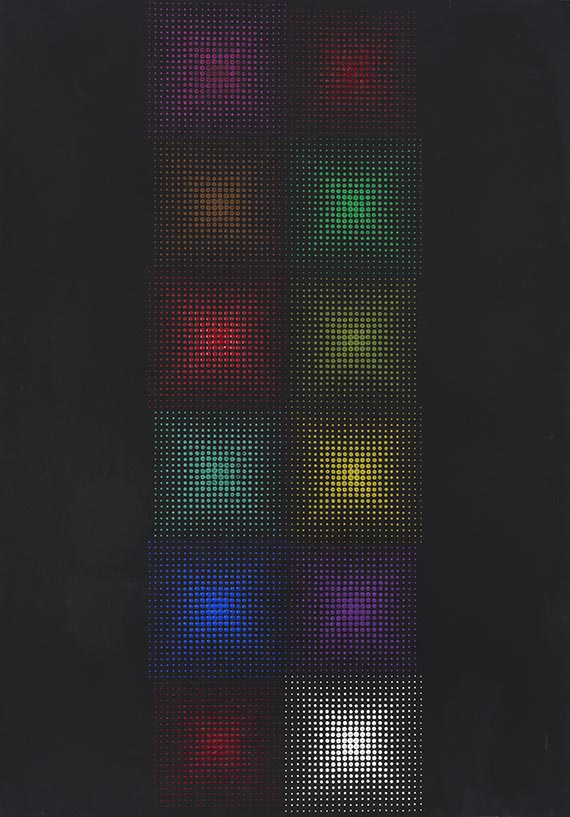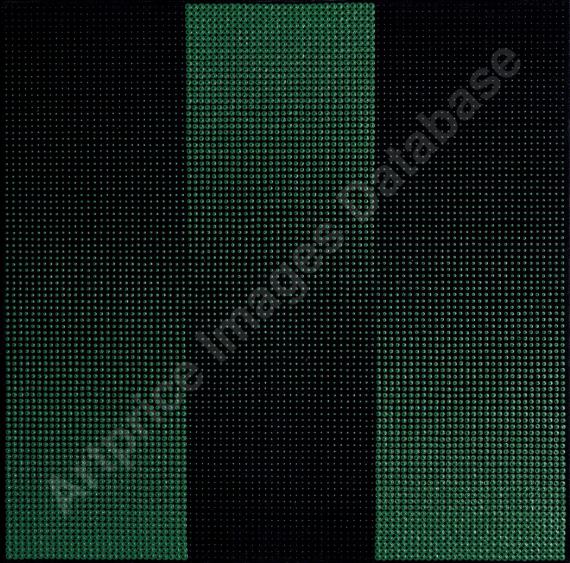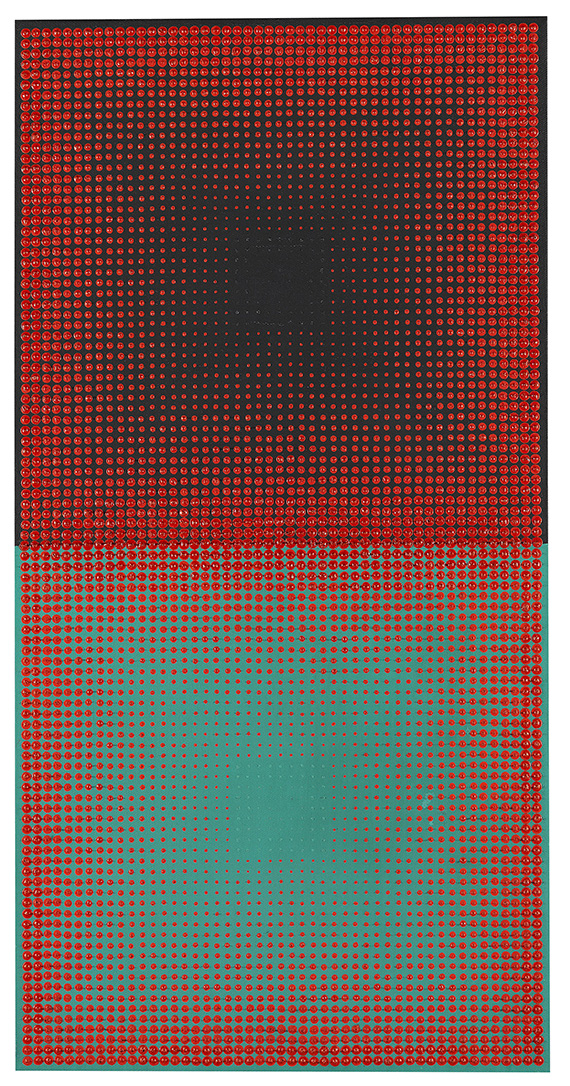319
Almir da Silva Mavignier
12 quadrate 3, 1967.
Olio su tela
Stima: € 100,000 / $ 110,000
12 quadrate 3. 1967.
Oil on canvas.
Signed, dated "hamburg 28.1.67" and inscribed with direction arrows on the reverse. With handwritten information on the color on the stretcher. 141 x 100 cm (55.5 x 39.3 in).
In the original frame. [KA].
• A highlight of Op Art.
• For the first time on the international auction market (source: artprice.com).
• Beautiful color contrast and intense light and dark contrast.
• In the 1960s, Mavignier participated in the Venice Biennale and documenta (1964 and 1968 respectively).
• Works by the artist can be found in, among others, the collection of the Museum of Modern Art, New York.
We would like to thank Mr. Delmar Mavignier for his kind assistance.
PROVENANCE: Private collection, South Germany.
EXHIBITION: Almir Mavignier, Kestner-Gesellschaft, Hanover, October 9 - November 24, 1968, cat. no. 70 (illustrated in color on p. 21) (with the label on the stretcher).
Almir Mavignier, Kestner-Gesellschaft, Hanover, October 9 - November 24, 1968, p. 8.
Called up: December 7, 2024 - ca. 16.10 h +/- 20 min.
Oil on canvas.
Signed, dated "hamburg 28.1.67" and inscribed with direction arrows on the reverse. With handwritten information on the color on the stretcher. 141 x 100 cm (55.5 x 39.3 in).
In the original frame. [KA].
• A highlight of Op Art.
• For the first time on the international auction market (source: artprice.com).
• Beautiful color contrast and intense light and dark contrast.
• In the 1960s, Mavignier participated in the Venice Biennale and documenta (1964 and 1968 respectively).
• Works by the artist can be found in, among others, the collection of the Museum of Modern Art, New York.
We would like to thank Mr. Delmar Mavignier for his kind assistance.
PROVENANCE: Private collection, South Germany.
EXHIBITION: Almir Mavignier, Kestner-Gesellschaft, Hanover, October 9 - November 24, 1968, cat. no. 70 (illustrated in color on p. 21) (with the label on the stretcher).
Almir Mavignier, Kestner-Gesellschaft, Hanover, October 9 - November 24, 1968, p. 8.
Called up: December 7, 2024 - ca. 16.10 h +/- 20 min.
From his beginnings in the first group of abstract painters in his native Brazil, Almir Mavignier has spent his career exploring the phenomenological effects of light and space in his work, which includes not only an impressive body of paintings but also a pioneering conception of posters in the early days of the medium.
Our large-format painting is an excellent example of Mavignier's approach to what Hegel (in many ways the artist's spiritual brother) calls "the spatial totality of the three dimensions" ((quoted from Exhib. cat. Kestner-Gesellschaft, Hanover, October 9 - November 24, 1968, p. 6).
In the present work, the artist has created a complex visual effect using a minimalist background, with dots of different sizes and geometric formations that appear to pop out of the canvas. The multitude of dots changes and blurs geometric structures the eye would otherwise recognize. Almir Mavignier calls this discovery the “geometry of the unknown.” Using a nail head soaked in paint; the artist created strictly geometrically arranged, protruding color grids. Their positions on the canvas are determined by a mathematical sequence, which explains the serial nature of the composition. The artist uses the relief structure of the three-dimensional color cones and the changing incidence of light to create a sensual and poetic pictorial effect. As a highlight of Op Art, the present work underscores this effect with its play with depth and strong color contrasts.
In the early 1950s, Mavignier was fascinated with the expressive forms of the Swiss Bauhaus artist Max Bill. He soon decided to move to Europe to study in Paris. A few years later, he enrolled at the renowned Ulm School of Design and became a student of Max Bill.
This was where he first experimented with geometric networks in the form of dots, his so-called "dot pictures." In 1954, he created the first work of this kind. The artist describes the process: "A progressive concentration of dots gave me a new solution to the problem of color gradients. At the same time, however, the resulting dot structure created a new relationship between color and light through the relief nature of this structure. This relief became even clearer in the further evolution of my painting, in which the dots became larger and even objects themselves." (Almir Mavignier, quoted from: Exhib. cat. Kestner-Gesellschaft, Hanover, October 9 - November 24, 1968, p. 8).
The precise application of dots on the canvas creates a series of optical illusions, such as the impression of depth, a distorted perception of color intensity, or the feeling of vibration. Almir Mavignier sees his experiments as an art form based on data theory, which postulates that a work of art is a symbol made up of micro symbols and forms a network based on strictly defined rules.
The works from around 1960, including "12 quadrate", are perhaps the most important in Mavignier's oeuvre. During this period, the artist gained greater international attention and participated in numerous important exhibitions. In 1964 and 1968, his works were shown at the Venice Biennale and the documenta in Kassel. In 1965, the Museum of Modern Art in New York showed two of his works alongside works by Josef Albers, Max Bill, Enrico Castellani, Ellsworth Kelly, Kenneth Noland, Ad Reinhardt, Bridget Riley, Frank Stella, and Victor Vasarely in the groundbreaking exhibition “The Responsive Eye.” [KA]
Our large-format painting is an excellent example of Mavignier's approach to what Hegel (in many ways the artist's spiritual brother) calls "the spatial totality of the three dimensions" ((quoted from Exhib. cat. Kestner-Gesellschaft, Hanover, October 9 - November 24, 1968, p. 6).
In the present work, the artist has created a complex visual effect using a minimalist background, with dots of different sizes and geometric formations that appear to pop out of the canvas. The multitude of dots changes and blurs geometric structures the eye would otherwise recognize. Almir Mavignier calls this discovery the “geometry of the unknown.” Using a nail head soaked in paint; the artist created strictly geometrically arranged, protruding color grids. Their positions on the canvas are determined by a mathematical sequence, which explains the serial nature of the composition. The artist uses the relief structure of the three-dimensional color cones and the changing incidence of light to create a sensual and poetic pictorial effect. As a highlight of Op Art, the present work underscores this effect with its play with depth and strong color contrasts.
In the early 1950s, Mavignier was fascinated with the expressive forms of the Swiss Bauhaus artist Max Bill. He soon decided to move to Europe to study in Paris. A few years later, he enrolled at the renowned Ulm School of Design and became a student of Max Bill.
This was where he first experimented with geometric networks in the form of dots, his so-called "dot pictures." In 1954, he created the first work of this kind. The artist describes the process: "A progressive concentration of dots gave me a new solution to the problem of color gradients. At the same time, however, the resulting dot structure created a new relationship between color and light through the relief nature of this structure. This relief became even clearer in the further evolution of my painting, in which the dots became larger and even objects themselves." (Almir Mavignier, quoted from: Exhib. cat. Kestner-Gesellschaft, Hanover, October 9 - November 24, 1968, p. 8).
The precise application of dots on the canvas creates a series of optical illusions, such as the impression of depth, a distorted perception of color intensity, or the feeling of vibration. Almir Mavignier sees his experiments as an art form based on data theory, which postulates that a work of art is a symbol made up of micro symbols and forms a network based on strictly defined rules.
The works from around 1960, including "12 quadrate", are perhaps the most important in Mavignier's oeuvre. During this period, the artist gained greater international attention and participated in numerous important exhibitions. In 1964 and 1968, his works were shown at the Venice Biennale and the documenta in Kassel. In 1965, the Museum of Modern Art in New York showed two of his works alongside works by Josef Albers, Max Bill, Enrico Castellani, Ellsworth Kelly, Kenneth Noland, Ad Reinhardt, Bridget Riley, Frank Stella, and Victor Vasarely in the groundbreaking exhibition “The Responsive Eye.” [KA]
319
Almir da Silva Mavignier
12 quadrate 3, 1967.
Olio su tela
Stima: € 100,000 / $ 110,000
Commissione, tassa e diritti di seguito
Quest'oggetto viene offerto con regime fiscale normale o con imposizione sul margine di profitto.
Calcolo commissione particolare sul margine del profitto:
- Prezzo d’aggiudicazione fino a 800.000 euro: provvigione del 32%.
- Per la parte del prezzo d’aggiudicazione superiore a 800.000 euro si calcola una provvigione del 27%, che viene aggiunta a quella relativa alla parte del prezzo d’aggiudicazione fino a 800.000 euro.
- Per la parte del prezzo d’aggiudicazione superiore a 4.000.000 euro si calcola una provvigione del 22%, che viene aggiunta a quella relativa alla parte del prezzo d’aggiudicazione fino a 4.000.000 euro.
Il prezzo d’acquisto comprende l’imposta sul valore aggiunto in vigore in quel momento, attualmente il 19%.
Calcolo regime fiscale normale:
Prezzo di aggiudicazione fino a 800.000 €: supplemento del 27%, più l´IVA legale
Prezzo di aggiudicazione superiore a 800.000 €: Parte del prezzo fino a 800.000 € supplemento del 27 %, parte del prezzo che supera i 800.000 € supplemento del 21%, a talvolta maggiorato dell'IVA legale.
Prezzo di aggiudicazione superiore a 4.000.000 €: Parte del prezzo che supera i 4.000.000 € supplemento del 15%, a talvolta maggiorato dell'IVA legale.
La preghiamo di avvisarci prima della fatturazione nel caso in cui desidera applicare il regime fiscale normale.
Calcolo diritti di seguito:
Per le opere originali di arti figurative e fotografie di artisti viventi o deceduti da meno di 70 anni soggette al diritto di seguito, in tutti i casi suddetti viene riscossa in aggiunta, a liquidazione della compensazione del diritto di seguito dovuto dalla casa d'aste ai sensi del § 26 della legge tedesca sul diritto d'autore (Urheberrechtsgesetz, UrhG), una compensazione del diritto di seguito con le percentuali indicate nel § 26 2° comma UrhG, che attualmente sono le seguenti:
4 per cento della parte del ricavo della vendita da 400,00 euro a 50.000 euro,
un altro 3 per cento della parte del ricavo della vendita da 50.000,01 a 200.000 Euro,
un altro 1 per cento della parte del ricavo della vendita da 200.000,01 a 350.000 Euro,
un altro 0,5 per cento della parte del ricavo della vendita da 350.000,01 a 500.000 euro e
un altro 0,25 per cento della parte del ricavo della vendita superiore a 500.000 euro.
L’importo complessivo della compensazione del diritto di seguito derivante da una rivendita è pari al massimo a 12.500 euro.
Calcolo commissione particolare sul margine del profitto:
- Prezzo d’aggiudicazione fino a 800.000 euro: provvigione del 32%.
- Per la parte del prezzo d’aggiudicazione superiore a 800.000 euro si calcola una provvigione del 27%, che viene aggiunta a quella relativa alla parte del prezzo d’aggiudicazione fino a 800.000 euro.
- Per la parte del prezzo d’aggiudicazione superiore a 4.000.000 euro si calcola una provvigione del 22%, che viene aggiunta a quella relativa alla parte del prezzo d’aggiudicazione fino a 4.000.000 euro.
Il prezzo d’acquisto comprende l’imposta sul valore aggiunto in vigore in quel momento, attualmente il 19%.
Calcolo regime fiscale normale:
Prezzo di aggiudicazione fino a 800.000 €: supplemento del 27%, più l´IVA legale
Prezzo di aggiudicazione superiore a 800.000 €: Parte del prezzo fino a 800.000 € supplemento del 27 %, parte del prezzo che supera i 800.000 € supplemento del 21%, a talvolta maggiorato dell'IVA legale.
Prezzo di aggiudicazione superiore a 4.000.000 €: Parte del prezzo che supera i 4.000.000 € supplemento del 15%, a talvolta maggiorato dell'IVA legale.
La preghiamo di avvisarci prima della fatturazione nel caso in cui desidera applicare il regime fiscale normale.
Calcolo diritti di seguito:
Per le opere originali di arti figurative e fotografie di artisti viventi o deceduti da meno di 70 anni soggette al diritto di seguito, in tutti i casi suddetti viene riscossa in aggiunta, a liquidazione della compensazione del diritto di seguito dovuto dalla casa d'aste ai sensi del § 26 della legge tedesca sul diritto d'autore (Urheberrechtsgesetz, UrhG), una compensazione del diritto di seguito con le percentuali indicate nel § 26 2° comma UrhG, che attualmente sono le seguenti:
4 per cento della parte del ricavo della vendita da 400,00 euro a 50.000 euro,
un altro 3 per cento della parte del ricavo della vendita da 50.000,01 a 200.000 Euro,
un altro 1 per cento della parte del ricavo della vendita da 200.000,01 a 350.000 Euro,
un altro 0,5 per cento della parte del ricavo della vendita da 350.000,01 a 500.000 euro e
un altro 0,25 per cento della parte del ricavo della vendita superiore a 500.000 euro.
L’importo complessivo della compensazione del diritto di seguito derivante da una rivendita è pari al massimo a 12.500 euro.




 Lot 319
Lot 319 


